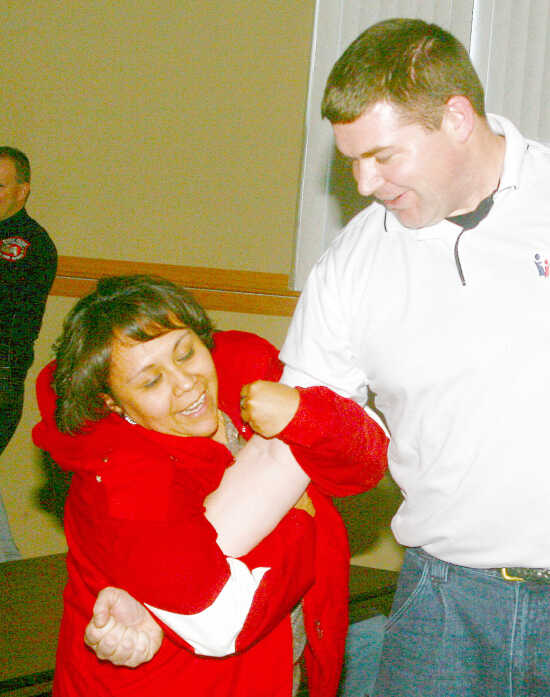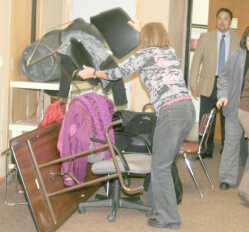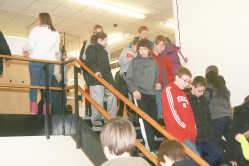School incident training emphasizes action

McCOOK, Nebraska -- They're smiling, and giggling. Hey, piling our school desks and chairs in front of the classroom door is fun.
It's only seven degrees outside -- "Do we actually have to go outside?"
Acting scared isn't easy to pull off.

But if the circumstances were real -- if an armed intruder were really stalking the hallways of one of McCook Public Schools' buildings -- there would be no smiling, no giggling. Barricading doors could keep the shooter outside the classroom ... at least slow him down.
Being absolutely quiet -- no talking, no crying -- won't draw the attention of someone carrying a weapon.
In a real shooter situation, no one would complain about leaving the building -- no matter how cold and slick, or hot, or windy it is.

Leaving the building -- rather than locking down exclusively -- is one of the more effective response tactics learned from studies of mass killings over the past 25 years.
Evacuation strategies are part of A.L.I.C.E., and A.L.I.C.E. is teaching McCook school administrators, teachers and students how to stay ALIVE.
McCook Police Officer/ School Resource Officer John Smith taught A.L.I.C.E. responses to McCook Public Schools' administrators, teachers and staff in late December and early January.
"We can't make you bulletproof and completely safe," Smith told teachers and staff at the training workshop. "But we can limit the risk."
A.L.I.C.E. is teaching school officials that a proactive response is better than a passive response.
Smith said, "The longer we sit and wait for the white knight, the more people get killed."
A.L.I.C.E. is an acronym for Alert, Lockdown, Inform, Counter, Evacuate. Smith said it's not a linear, progressive step-by-step process. He explained that if the intruder "alert" and "lockdown" order have gone out, doors have been barricaded, and the "information" is that the intruder is in the eastern part of the building, then teachers and students in the western parts of the building may have the opportunity to "evacuate" -- quickly and quietly.
"Be flexible, because the situation is dynamic and fluid," Smith said. He encouraged as much communication within the building as possible and by as many means as possible (PA system, Facebook, texting). "Keep telling people where he's at," Smith said. "Be a play-by-play announcer."
Studies have shown that what school officials have taught in the past about "lockdown" -- secure-in-place -- hasn't always been the best response, Smith said. In the Virginia Tech shooting in April 2007, more students were killed or wounded in classrooms that were locked down than in those that were locked down and doors barricaded ("heavy objects make good obstacles," Smith said), or classrooms in which students locked down, barricaded and (some) jumped.
McCook Junior High Principal Dennis Berry said any employee has the authority to call a lockdown, "not just an administrative staff member."
McCook Elementary Principal Tim Garcia said that staff members have the discretionary power to evacuate their classrooms, to get students away from the school.
Berry said he does not want personnel to become paranoid, "but we're giving employees the right to make decisions -- in situations of imminent danger -- to move students or not."
Although the schools have designated reunification places, Garcia told those at the training, "Go where you have to go to be safe," Garcia said. Berry added, "Get the heck out of Dodge."
Forget the idea of staying together, holding hands, staying in groups -- providing large target areas, Garcia said. "Go, go now and get the kids away."
Berry said, "Tell the kids, 'Meet me behind the gray house'." If a neighbor waves evacuating teachers and kids inside, go inside, trainers say.
History shows that it is unlikely there's another shooter waiting outside. "You KNOW there's someone inside," said McCook Elementary Principal Tim Garcia. Smith added, "If he's inside, you get outside." Smith said that only 2 percent of violent intruder events have been perpetrated by more than one person.
Don't let fences be a deterrent to running, Garcia said. "Get over the fence, under the fence. Lift kids over." A fence is a deterrent to a shooter carrying a weapon. "It buys me some time," Garcia said.
Using the "countering" strategy of A.L.I.C.E, Smith said, "You can survive (direct) contact with an armed intruder." Make noise, move around, create distractions and diversions. Defend yourself; don't be a sitting duck; don't give a shooter an easy target. "Interrupt the skill set he needs to shoot accurately," he said. "The bad guy is not usually an excellent marksman. Interrupt his accuracy and he's less likely to hit someone."
Teachers -- not students -- will learn tactics to swarm an intruder -- not with the specific goal of taking away a firearm, but by a group of teachers grabbing his arms and legs in such a manner that he loses his balance, his accuracy is diminished, he drops his firearm, he falls to the ground and he can be restrained.
"Do NOT come out of the building carrying his firearm," McCook Police Sgt. Kevin Darling said. "That's exactly who we're looking for." Put the weapon in a wastebasket, and contact law enforcement immediately.
Berry said students will not be taught to disarm an intruder. "That IS an option," he admitted. "But it's the VERY last option."
Smith said, "I'm not asking you to put your life at risk," but he told school staff members of two instances in which citizens stopped what could have escalated into mass killings:
* At Reno, Nevada, Pine Middle School on April 28, 2008, gym teacher Jencie Fagan empathized with shooter James Scott Newman, offering him understanding and persuading him to place his gun on the floor. She physically restrained him until additional staff arrived.
* At Deer Creek Middle School in Jefferson County, Colorado, on Feb. 23, 2010, when Bruco Strong Eagle Eastwood opened fire on students, the incident was minimized by math teacher David Benke, who tackled Eastwood and restrained him until he could be taken into custody.
Berry told teachers and staff members at the training that the teacher and staff trainings and the lockdown, barricading and evacuation practices in the classrooms should be taken seriously. "It can happen here," he said. "in our type of community."
The schools' crisis plans have been reviewed and revised every year for the past 15-20 years, Berry said, incorporating proven and studied techniques, tactics and strategies. "But we still cannot plan for every 'what if'."
He concluded, telling school personnel, "The biggest thing -- control your emotions. Keep your head. If you lose it, the kids will lose it."
